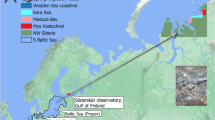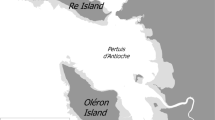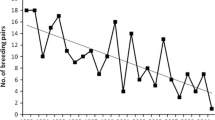Abstract
Populations of migratory species have undergone dramatic changes in recent decades, but little is known about the factors actually driving those changes. Of particular concern are quarry species such as migratory ducks (Anatidae), many of which have an unfavourable conservation status in Europe. By including both quarry and non-quarry species, as well as habitat preference and life history characteristics of the species, we investigated the relative importance of hunting pressure, both in Finland and at the European level, in explaining population changes of 16 species of migratory waterbirds in Finland during 1986–2011. Ban of lead shot in 1996 resulted in considerably lower annual hunting bags in Finland thereafter. Species which had the highest hunting pressure had the most negative slopes in population trends from 1986 up to 1997, suggesting that hunting probably limited those populations. However, in general population trends of the species were not strongly associated with hunting pressure in Finland or in Europe. Nor were basic life history characteristics (body mass and clutch size) associated with population trends of the species. In contrast, recent population declines were associated with habitat preferences of the species: those breeding mainly in eutrophic lakes had more negative population trends than those breeding in oligotrophic lakes or generalist species. Reasons for the relatively poor status of species preferring eutrophic lakes probably include over-eutrophication of nutrient-rich lakes, resulting in less abundant food resources, and increased nest depredation.



Similar content being viewed by others
References
Alhainen M, Väänänen V-M, Pöysä H, Ermala A (2010) Duck hunting bag in Finland – what do wing samples tell us about the species composition and age structure in a bag? Suomen Riista 56:40–47, in Finnish with English summary
BirdLife International (2004) Birds in the European Union: A status assessment. BirdLife International, Wageningen
BirdLife International (2012) The BirdLife checklist of the birds of the world, with conservation status and taxonomic sources. Version 5. http://www.birdlife.info/im/species/checklist.zip. Accessed 6 September 2012
Both C, van Turnhout CAM, Bijlsma RG, Siepel H, van Strien AJ, Foppen RPB (2010) Avian population consequences of climate change are most severe for long-distance migrants in seasonal habitats. Proc R Soc B 277:1259–1266
Brommer JE (2008) Extent of recent polewards range margin shifts in Finnish birds depends on their body mass and feeding ecology. Ornis Fenn 85:109–117
Brown P, Zhou L (2010) MCMC for Generalized Linear Mixed Models with glmmBUGS. R J 2:13–17
Cormont A, Vos CC, van Turnhout CAM, Foppen RPB, ter Braak CJF (2011) Using life-history traits to explain bird population responses to changing weather variability. Clim Res 49:59–71
Cramp S (ed) (1985) The birds of the Western Palearctic, vol. IV. Oxford University Press, Oxford
Cramp S, Simmons KEL (eds) (1977) The birds of the Western Palearctic, vol. I. Oxford University Press, Oxford
Delany S, Scott D (2006) Waterbird population estimates, 4th edn. Wetlands International, Wageningen
R Development Core Team (2012) R: A language and environment for statistical computing. http://www.r-project.org. Accessed 16 September 2012
Devineau O, Guillemain M, Johnson AR, Lebreton J-D (2010) A comparison of green-winged teal Anas crecca survival and harvest between Europe and North America. Wildl Biol 16:12–24
Duncan RP, Blackburn TM, Worthy TH (2002) Prehistoric bird extinctions and human hunting. Proc Royal Soc Lond B 269:517–521
Ekholm P, Mitikka S (2006) Agricultural lakes in Finland: current water quality and trends. Environ Monit Assess 116:111–135
Ellermaa M, Lindén A (2011) IBA-monitoring tells us: birds are not taken seriously in Finnish bird protection areas. Yearb Linnut Mag 2010:143–168, in Finnish with English summary
Elmberg J, Nummi P, Pöysä H, Sjöberg K (1993) Factors affecting species number and density of dabbling duck guilds in North Europe. Ecography 16:251–260
Elmberg J, Nummi P, Pöysä H, Sjöberg K, Gunnarsson G, Clausen P, Guillemain M, Rodrigues D, Väänänen V-M (2006) The scientific basis for new and sustainable management of migratory European ducks. Wildl Biol 12:121–127
Elmberg J, Dessborn L, Englund G (2010) Presence of fish affects lake use and breeding success in ducks. Hydrobiologia 641:215–223
Finnish Game and Fisheries Research Institute (1998) Annual game bag 1996. Official Statistics of Finland – Agriculture, Forestry and Fishery
Finnish Game and Fisheries Research Institute (2002) Annual game bag 2001. Official Statistics of Finland – Agriculture, Forestry and Fishery
Finnish Game and Fisheries Research Institute (2007) Annual game bag 2006. Riista-ja kalatalous – Tilastoja 5/2007. Official Statistics of Finland – Agriculture, Forestry and Fishery
Finnish Game and Fisheries Research Institute (2009) Hunting 2008. Riista-ja kalatalous – Tilastoja 5/2009. Official Statistics of Finland – Agriculture, Forestry and Fishery
Finnish Game and Fisheries Research Institute (2010) Hunting 2009. Riista-ja kalatalous – Tilastoja 6/2010. Official Statistics of Finland – Agriculture, Forestry and Fishery
Finnish Game and Fisheries Research Institute (2011) Hunting 2010. Riista-ja kalatalous – Tilastoja 6/2010. Official Statistics of Finland – Agriculture, Forestry and Fishery
Gelman A, Carlin JB, Stern HS, Rubin DB (2003) Bayesian data analysis, 2nd edn. Chapman & Hall/CRC, Boca Raton
Giles N (1994) Tufted duck (Aythya fuligula) habitat use and brood survival increases after fish removal from gravel pit lakes. Hydrobiologia 279–280:387–392
Green AJ (1996) Analyses of globally threatened Anatidae in relation to threats, distribution, migration patterns, and habitat use. Conserv Biol 10:1435–1445
Hagemeijer WJM, Blair MJ (eds) (1997) The EBCC atlas of European breeding birds: Their distribution and abundance. T&A D Poyser, London
Hanson MA, Butler MG (1994) Responses to food web manipulation in a shallow waterfowl lake. Hydrobiologia 279–280:457–466
Herzon I, Auninš A, Elts J, Preikša Z (2008) Intensity of agricultural land-use and farmland birds in the Baltic States. Agr Ecosyst Environ 125:93–100
Herzon I, Ekroos J, Rintala J, Tiainen J, Seimola T, Vepsäläinen V (2011) Importance of set-aside for breeding birds of open farmland in Finland. Agr Ecosyst Environ 143:3–7
Hilli-Lukkarinen M, Kuitunen M, Suhonen J (2011) The effect of changes in land use on waterfowl species turnover in Finnis boreal lakes. Ornis Fenn 88:185–194
Hirschfeld A, Heyd A (2005) Mortality of migratory birds caused by hunting in Europe: bag statistics and proposals for the conservation of birds and animal welfare. Ber Vogelschutz 42:47–74
Jylhä K, Tuomenvirta H, Ruosteenoja K (2004) Climate change projections for Finland during the 21st century. Boreal Environ Res 9:127–152
Kauppi L, Pietiläinen O-P, Knuuttila S (1993) Impacts of agricultural nutrient loading on Finnish watercourses. Water Sci Technol 28:461–471
Kauppinen J (1993) Densities and habitat distribution of breeding waterfowl in boreal lakes in Finland. Finn Game Res 48:24–45
Kauppinen J, Väisänen RA (1993) Ordination and classification of waterfowl communities in south boreal lakes. Finn Game Res 48:3–23
Knudsen E, Lindén A, Both C, Jonzén N, Pulido F, Saino N, Sutherland WJ, Bach LA, Coppack T, Ergon T, Gienapp P, Gill JA, Gordo O, Hedenström A, Lehikoinen E, Marra PP, Møller AP, Nilsson ALK, Péron G, Ranta E, Rubolini D, Sparks TH, Spina F, Studds CE, Sæther SA, Tryjanowski P, Stenseth NC (2011) Challenging claims in the study of migratory birds and climate change. Biol Rev 86:928–946
Koskimies P, Väisänen RA (1991) Monitoring bird populations. Zoological Museum. Finnish Museum of Natural History, Helsinki
Long PR, Székely T, Kershaw M, O’Connell M (2007) Ecological factors and human threats both drive wildfowl population declines. Anim Conserv 10:183–191
Lunn DJ, Thomas A, Best N, Spiegelhalter D (2000) WinBUGS – a Bayesian modelling framework: concepts, structure, and extensibility. Stat Comput 10:325–337
Lunn D, Spiegelhalter D, Thomas A, Best N (2009) The BUGS project: evolution, critique and future directions. Stat Med 2009:3049–3067
Martinez-Haro M, Green AJ, Mateo R (2011) Effects of lead exposure on oxidative stress biomarkers and plasma biochemistry in waterbirds in the field. Environ Res 111:530–538
Mateo R (2009) Lead poisoning in wild birds in Europe and the regulations adopted by different countries. In: Watson RT, Fuller M, Pokras M, Hunt WG (eds) Ingestion of lead from spent ammunition: Implications for wildlife and human. The Peregrine Fund, Boise, pp 1–28
McCullagh P, Nelder JA (1989) Generalized linear models. Chapman and Hall, London
Meier HEM, Hordoir R, Andersson HC, Dieterich K, Gustafsson BG, Höglund A, Schimanke S (2012) Modelling the combined impact of changing climate and changing nutrient loads on the Baltic Sea environment in an ensemble of transient simulations for 1961–2099. Clim Dyn (in press). doi:10.1007/s00382-012-1339-7
Mikkola-Roos M, Tiainen J, Below A, Hario M, Lehikoinen A, Lehikoinen E, Lehtiniemi T, Rajasärkkä A, Valkama J, Väisänen RA (2010) Linnut — Birds. In: Rassi P, Hyvärinen E, Juslén A, Mannnerkoski I (eds) The 2010 red list of Finnish species. Ministry of the Environment, Finnish Environment Institute, Helsinki, pp 320–321
Møller AP, Fiedler W, Berthold P (eds) (2010) Effects of climate change on birds. Oxford University Press, Oxford
Mooij JH (2005) Protection and use of waterbirds in the European Union. Beitr zur Jagd- und Wildforschung 30:49–76
Newton I (1998) Population limitation in birds. Academic Press, San Diego
Nichols JD (1991) Responses of North American duck populations to exploitation. In: Perrins CM, Lebreton J-D, Hirons GJM (eds) Bird population studies: Relevance to conservation and management. Oxford University Press, Oxford, pp 448–525
Nichols JD, Runge MC, Johnson FA, Williams BK (2007) Adaptive harvest management of North American waterfowl populations: a brief history and future prospects. J Ornithol 148:343–349
Nordström M, Högmander J, Nummelin J, Laine J, Laanetu N, Korpimäki E (2002) Variable responses of waterfowl breeding populations to long-term removal of introduced American mink. Ecography 25:385–394
Nordström M, Högmander J, Laine J, Nummelin J, Laanetu N, Korpimäki E (2003) Effects of feral mink removal on seabirds, waders and passerines on small islands in the Baltic Sea. Biol Conserv 109:359–368
Nummi P, Väänänen V-M, Rask M, Nyberg K, Taskinen J (2012) Competitive effects of fish in structurally simple habitats: perch, invertebrates, and goldeneye in small boreal lakes. Aquatic Sci 74:343–350
Olden JD, Hogan ZS, Zanden MJV (2007) Small fish, big fish, red fish, blue fish: size-biased extinction risk of the world’s freshwater and marine fishes. Global Ecol Biogeogr 16:694–701
Olin M, Rask M, Ruuhijärvi J, Kurkilahti M, Ala-Opas P, Ylönen O (2002) Fish community structure in mesotrophic and eutrophic lakes of southern Finland: the relative abundances of percids and cyprinids along a trophic gradient. J Fish Biol 60:593–612
Owens IPF, Bennett PM (2000) Ecological basis of extinction risk in birds: habitat loss versus human persecution and introduced predators. PNAS 97:12144–12148
Pain DJ (1990) Lead poisoning of waterfowl: A review. In: Matthews GVT (ed) Managing waterbird populations. Proc IWRB Symp, Astrakhan, USSR. IWRB Special Publication No. 12, pp 172–181
Pannekoek J, van Strien AJ (2005) Trim 3 manual (Trends and indices for monitoring data). Statistics Netherlands, Voorburg
Patterson JH (1979) Can ducks be managed by regulation? Experiences in Canada. Trans North Am Wildl Nat Res Conf 44:130–139
Pearce-Higgins J, Yalden D, Dougall T, Beale C (2009) Does climate change explain the decline of a trans-Saharan Afro-Palaearctic migrant? Oecologia 159:649–659
Pirkola MK, Lindén H (1972) Results of duck wing collection surveys in Finland 1969 and 1970. Suomen Riista 24:97–106, in Finnish with English summary
Pöysä H, Väisänen RA, Wikman M (1993) Monitoring of waterbirds in the breeding season: the programme used in Finland in 1986–92. In: Moser M, Prentice RC, van Vessem J (eds) Waterfowl and wetland conservation in the 1990s — a global perspective. Proc IWRB Symp, St Petersburg Beach, FL, USA. IWRB Special Publication No 26, pp 7–12
Pöysä H, Elmberg J, Gunnarsson G, Nummi P, Sjöberg K (2004) Ecological basis of sustainable harvesting: is the prevailing paradigm of compensatory mortality still valid? Oikos 104:612–615
Pöysä H, Rintala J, Wikman M, Lehikoinen A, Väisänen RA (2011) RKTL — Vesilinnut 2011. http://www.rktl.fi/riista/riistavarat/vesilinnut_2.html. Accessed 14 May 2012
Rask M, Olin M, Ruuhijärvi J (2010) Fish-based assessment of ecological status of Finnish lakes loaded by diffuse nutrient pollution from agriculture. Fish Manage Ecol 17:126–133
Rendón MA, Green AJ, Aguilera E, Almaraz P (2008) Status, distribution and long-term changes in the waterbird community wintering in Doñana, south-west Spain. Biol Conserv 141:1371–1388
Reynolds RE, Sauer JR (1991) Changes in mallard breeding populations in relation to production and harvest rates. J Wildl Manage 55:483–487
Rönkä MTH, Saari CLV, Lehikoinen EA, Suomela J, Häkkilä K (2005) Environmental changes and population trends of breeding waterfowl in northern Baltic Sea. Ann Zool Fenn 42:587–602
Sanderson FJ, Donald PF, Pain DJ, Burfield IJ, van Bommel FPJ (2006) Long-term population declines in Afro-Palearctic migrant birds. Biol Conserv 131:93–105
Simola H, Kukkonen M, Lahtinen J, Tossavainen T (1995) Effects of intensive forestry and peatland management on forest lake ecosystems in Finland: sedimentary records of diatom floral changes. In: Marino D (ed) Proceedings of the Thirteenth International Diatom Symposium, Maratea, Italy, 1–7th September 1994. Biopress. Bristol, pp 121–128
Sjöberg K, Pöysä H, Elmberg J, Nummi P (2000) Response of mallard ducklings to variation in habitat quality: an experiment of food limitation. Ecology 81:329–335
Smith GW, Reynolds RE (1992) Hunting and mallard survival, 1979–88. J Wildl Manag 56:306–316
Solonen T (1985) Suomen linnusto. Lintutieto, Helsinki
Spiegelhalter DJ, Best NG, Carlin BP, Linde AVD (2002) Bayesian measures of model complexity and fit. J R Statist Soc B 64:583–639
Spiegelhalter D, Thomas A, Best N, Lunn D (2003) WinBUGS user manual. http://www.mrc-bsu.cam.ac.uk/bugs/winbugs/manual14.pdf. Accessed 16 September 2012
Stoate C, Báldi A, Beja P, Boatman ND, Herzon I, van Doorn A, de Snoo GR, Rakosy L, Ramwell C (2009) Ecological impacts of early 21st century agricultural change in Europe — a review. J Environ Manage 91:22–46
Sturtz S, Ligges U, Gelman A (2005) R2WinBUGS: a package for running WinBUGS from R. J Stat Softw 12:1–16
Väänänen V-M (2000) Predation risk associated with nesting in gull colonies by two Aythya species: observations and an experimental test. J Avian Biol 31:31–35
Väänänen V-M (2011) Small colonial larids and waterfowl — the effect of gull colonies on waterfowl nesting in inland eutrophic wetlands. Suomen Riista 57:84–91, in Finnish with English summary
Väänänen V-M, Nummi P, Rautiainen A, Asanti T, Huolman I, Mikkola-Roos M, Nurmi J, Orava R, Rusanen P (2007) The effect of raccoon dog Nyctereutes procyonoides removal on waterbird breeding success. Suomen Riista 53:49–63, in Finnish with English summary
Väänänen V-M, Nummi P, Pöysä H, Rask M, Nyberg K (2012) Fish–duck interactions in boreal lakes in Finland as reflected by abundance correlations. Hydrobiologia 697:85–93
Väisänen RA, Lammi E, Koskimies P (1998) Distribution, numbers and population changes of Finnish breeding birds. Finnish Museum of Natural History, University of Helsinki, Otava, in Finnish with English summary
Väisänen RA, Hario M, Saurola P (2011) Population estimates of Finnish birds. In: Valkama J, Vepsäläinen V, Lehikoinen A (eds) The third Finnish breeding bird atlas. Finnish Museum of Natural History and Ministry of Environment. http://atlas3.lintuatlas.fi/english. Accessed 14 May 2012
Valkama J, Vepsäläinen, V, Lehikoinen, A (2011) The third Finnish breeding bird atlas. Finnish Museum of Natural History and Ministry of Environment. http://atlas3.lintuatlas.fi/english. Accessed 14 May 2012
von Haartman L (1973) Changes in the breeding bird fauna of North Europe. In: Farnes DS (ed) Breeding biology of birds. National Academy of Sciences, Washington DC, pp 448–481
Wagenmakers E-J, Farrell S (2004) AIC model selection using Akaike weights. Psychon B Rev 11:192–196
Acknowledgments
We would like to thank all the hundreds of hunters and bird watchers that have participated in waterbird surveys in Finland. We also thank Pirjo Hätönen, Ritva Koivunen, Heikki Koivunen, Esa Lammi, Petri Timonen and Marcus Wikman for processing census forms and for computerizing the data and Eija Nylander for compiling the Finnish hunting bag statistics. Comments by two anonymous reviewers greatly improved the text. The Nordic Waterbirds And Climate Network (NOWAC) provided inspiring atmosphere that boosted the writing of this manuscript.
Author information
Authors and Affiliations
Corresponding author
Additional information
Communicated by C. Gortázar
Rights and permissions
About this article
Cite this article
Pöysä, H., Rintala, J., Lehikoinen, A. et al. The importance of hunting pressure, habitat preference and life history for population trends of breeding waterbirds in Finland. Eur J Wildl Res 59, 245–256 (2013). https://doi.org/10.1007/s10344-012-0673-8
Received:
Revised:
Accepted:
Published:
Issue Date:
DOI: https://doi.org/10.1007/s10344-012-0673-8




